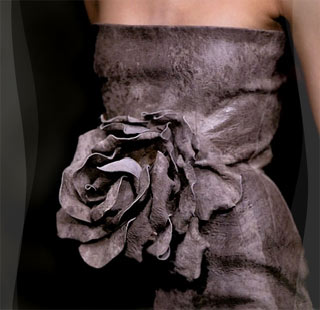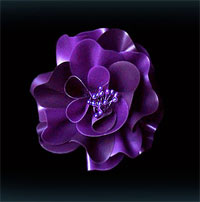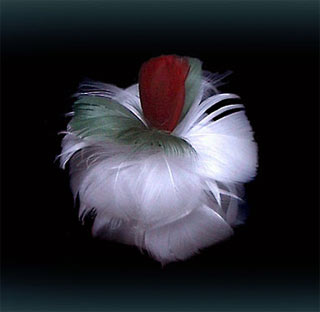Human Flower Project
Friday, April 27, 2007
Legeron: A Flower at the Waist
The Paris fashion world has plenty of designers but not enough “little hands.”

Junko Shimada dress with Legeron flower
Photo: Legeron
“Who knows how to do this anymore?” asked cousin Ben, leafing through a gorgeous book about the optics, engineering, botanical and design wizardry that built the gardens of Versailles.
The same question applies to many smaller human flower projects, much smaller ones – like the ersatz peony on your grandmother’s hat. Jenny Barchfield’s excellent story for AP profiles Bruno Legeron, owner of France’s last remaining independent flower-making company.
His great-grandfather started the business in 1880, when every hem, waist, and lapel begged for a blossom. By the end of World War II “Paris had hundreds of independent flower-makers,” writes Barchfield. But no longer. Legeron’s “last two competitors, Guillet and Lemarie, were bought by Chanel.”
 Custom-made beaded flower
Custom-made beaded flower
Photo: Legeron
Barchfield describes how haute couture has always depended on the “petites mains” (“little hands”) of such artisans. Concern among the fashion houses is building into alarm, as the craftspeople who made hat blocks and buttons, beaded embroidery, and turned out silk and feather flowers retire. No one’s replacing them.
“Few young people are drawn by the low-paying and fiddly work,” Barchfield observes. Though 50-year-old Legeron is a fourth generation flower maker, he looks to be the end of the line. “It’s a vicious circle,” he said. “Because I spend my life in the workshop, I never got out to find a wife, which means I don’t have a kid and won’t have anyone to leave this place to when the time comes.”
 Feather flower by Legeron
Feather flower by Legeron
Photo: Legeron
Consider that as you enjoy the company’s beautiful website, with both single flower portraits and embellished fashions by Dior, Ungaro, and others. These don’t look at all like the artificial flowers one finds at the hobby shops; they were never meant to be replicas. Hand-crafted or machine-made flowers, to our eyes, are only gross insofar as they try to fake it. But who’s ever seen blooms quite like these? They aren’t fake flowers but imagined flowers. Many of the loveliest ones are grey.
Barchfield writes, “Each Legeron made-to-order blossom takes up to an hour to assemble and retails for the equivalent of $39 to $133.” We would be very interested to know more about the company – How many people does it employ? Where were they trained? How does someone stop imitating violets and start intimating them?
In the liberties Legeron’s artisans have taken, we see again what Jim Wandersee and Renee Clary described in their most recent post: here are flower makers who “value essence over fidelity.”




